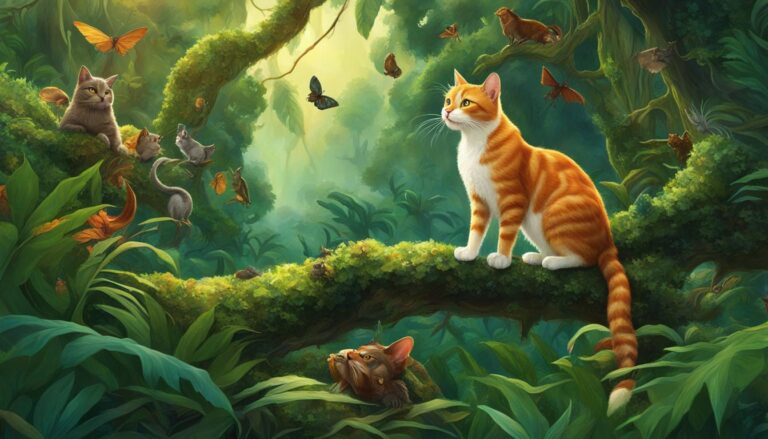Welcome to our exploration of the fascinating world of cat vocalization (meow). Have you ever wondered why your feline friend meows? Cats have their own unique ways of communicating with us, and understanding their meows can deepen our bond. In this article, we will delve into the reasons behind cat meowing, shedding light on their behavior and communication patterns. So, let’s dive in and uncover the secrets of the meowing mystery!
Punti di forza:
- Cats use meowing as a way to express their needs, seek attention, and convey emotions.
- Meowing has evolved as a means of communication between cats and humans.
- Cultural perspectives on cat meowing vary, with beliefs and superstitions surrounding its significance.
- Different types of meows indicate various emotions and needs.
- Understanding cat meows involves analyzing context, body language, and circumstances.
Evolutionary Reasons for Meowing
Evolution has played a significant role in shaping the communication between cats and humans. Cats have adapted their meowing behavior to effectively communicate their needs, seek attention and interaction, and express hunger or discomfort. This evolutionary response has strengthened the bond between cats and humans, allowing for better understanding and care.
Meowing serves as a way for cats to communicate their needs to humans. Whether it’s a longing for food, water, or even playtime, cats have learned to use their meows as a means of catching our attention. Through meowing, cats have developed a way to interact with us, forging a deeper connection and enhancing their well-being.
Expressing hunger or discomfort is another important function of meowing in cats. When a cat is hungry or in pain, they may use different pitches or patterns in their meows to convey their distress. As humans, it is crucial for us to be attentive to these cues and provide the necessary care and attention to our feline companions.
| Evolutionary Reasons for Meowing | Examples |
|---|---|
| Seeking Attention or Interaction | A cat meows to get your attention for playtime or cuddles. |
| Expressing Hunger or Discomfort | A cat’s meow may become more persistent or demanding when they are hungry or in pain. |
| Bonding with Humans | Meowing is a way for cats to establish a connection with their owners and strengthen their bond. |
Comprendere il evolutionary reasons for meowing can help us build a stronger bond with our feline friends and ensure their well-being. By being attentive to their meows and responding appropriately, we can meet their needs and provide them with a loving and nurturing environment.
While there are various reasons why cats meow, the evolutionary aspect of their vocalization is a key factor in their communication with humans. By recognizing the significance of meowing as an evolutionary response, we can deepen our understanding and appreciation for our furry companions, paving the way for a harmonious and fulfilling relationship.
Cultural Perspectives on Cat Meowing
In addition to the biological and evolutionary reasons behind cat meowing, various cultures around the world have attached symbolic meanings to this vocalization. One fascinating cultural perspective on cat meowing can be found in Feng Shui beliefs and interpretations. Feng Shui, an ancient Chinese practice, involves analyzing and harmonizing the energy flow in a space. In this context, meowing cats are believed to carry specific energies that can be indicative of the overall energy layout of a location.
According to Feng Shui, a cat’s meow can serve as a tool for practitioners to assess and improve the flow of energy in a home or workspace. The pitch, frequency, and intensity of the meow are believed to hold valuable insights. Meowing cats are considered to be guardians of positive energy and are believed to protect the space from negative influences. Feng Shui practitioners may interpret a cat’s meow as a communication from the divine or a sign of good fortune.
“The meow of a cat is not just a sound but a powerful resonance that can guide us towards harmony and balance.” Feng Shui Master Wang Li
Superstitions and myths surrounding cat meowing can also provide intriguing cultural perspectives. In some cultures, meowing cats are believed to bring either good luck or misfortune, depending on the circumstances. For example, it is commonly believed that a cat meowing at night is a harbinger of bad luck or death. On the other hand, in certain cultures, a cat’s meow is considered a sign of impending financial fortune or the arrival of a much-anticipated visitor.
These cultural perspectives on cat meowing highlight the rich tapestry of beliefs and interpretations that humans have woven around this enigmatic behavior. While scientific explanations focus on the biological and evolutionary aspects, understanding these cultural viewpoints can deepen our appreciation for the significance of cat meowing in different societies.
Table: Cultural Interpretations of Cat Meowing
| Culture | Interpretation |
|---|---|
| Chinese Feng Shui | Meowing cats are associated with positive energy and used as a tool for analyzing the energy layout of a space. |
| Western Superstitions | Meowing cats are seen as omens, indicating either good luck or misfortune depending on the circumstances and beliefs. |
| Other Cultures | Interpretations may vary, with some cultures associating cat meowing with financial fortune or the arrival of special guests. |
While these cultural perspectives may seem fantastical to some, they reflect the enduring fascination humans have with the mysterious and alluring behavior of cats. Whether viewed through a scientific or cultural lens, cat meowing continues to captivate our hearts and minds, reminding us of the unique and intricate bond we share with our feline companions.
Different Types of Meows and Their Meanings
Cats have a unique way of communicating through their meows, using different types of sounds to express their emotions and needs. Understanding the meanings behind these meows can help you develop a stronger bond with your feline companion. Here are some common types of meows and what they may signify:
1. High-pitched meows:
High-pitched meows are often associated with curiosity, attention-seeking, or a request for interaction. When your cat lets out a series of short, high-pitched meows, it may be expressing excitement or trying to get your attention. Similarly, if your cat is meowing in a high tone while looking at something, it could be a sign of curiosity or interest in that particular object or situation.
2. Low-pitched or growling meows:
Low-pitched or growling meows usually indicate discontent or a warning sign of fear or aggression. If your cat is growling or making low-pitched meows, it’s essential to assess the situation and identify any potential sources of stress or discomfort. It’s best to give your cat space and allow them to calm down before attempting to interact with them.
3. Prolonged or continuous meows:
If your cat is continuously meowing or making prolonged meows, it could be a way of seeking attention or expressing discomfort or pain. This type of meow may also indicate boredom, loneliness, or a need for companionship. It’s important to pay attention to the context and body language accompanying these meows to determine the underlying cause and address your cat’s needs.
Interpreting cat meows involves considering the entire communication package, including body language, facial expressions, and the context in which the meowing occurs. By observing your cat’s behavior and paying attention to their vocalizations, you can develop a better understanding of their needs and emotions.
Remember, every cat is unique, and their meowing patterns may vary. Spending time with your cat and being attentive to their vocalizations will enable you to build a stronger bond and provide the care and attention they require.
Conclusione
The enigmatic beauty of cats and their meowing behavior continues to captivate and intrigue us. By understanding the reasons behind cat meowing and embracing the unique communication style of cats, you can forge stronger bonds and provide them with the care they need.
Being a cat owner brings both joys and challenges. The joys include the unconditional love and playful companionship that cats offer. However, there are also challenges, such as litter box maintenance and the potential for allergies. Despite these challenges, the joys of being a cat owner far outweigh them.
To live harmoniously with cats, it is important to prioritize their well-being. Provide them with a comfortable and stimulating environment, regular veterinary care, and a healthy diet. Pay attention to their body language and meowing patterns to understand their needs and emotions. By following these tips and embracing the enigmatic beauty of cats, you can experience the joys of cat ownership to the fullest.
Link alla fonte
- https://blog.catbandit.com/understanding-cat-behavior-the-mystery-behind-meowing-before-using-the-litter-box/
- https://www.katdootje.nl/blog-en/why-do-cats-meow/?lang=en
- https://medium.com/@vishwanijayasooriya4/unveiling-the-mystery-of-a-cats-life-exploring-the-enigmatic-world-of-our-feline-friends-a40ef572f0f8




